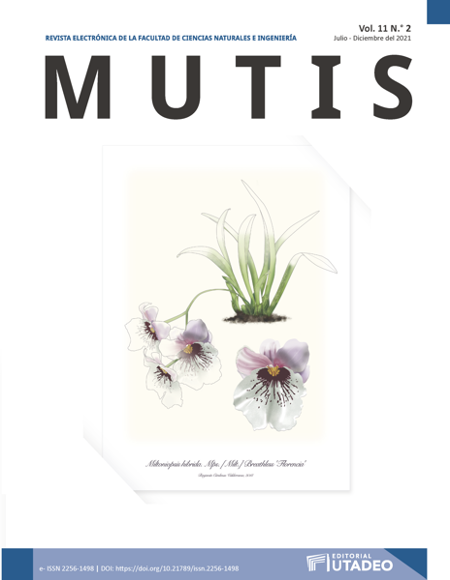
Esta obra está bajo una licencia internacional Creative Commons Atribución-NoComercial-CompartirIgual 4.0.
Esta obra está bajo una licencia internacional Creative Commons Atribución-NoComercial-CompartirIgual 4.0.
Resumen
Haematococcus pluvialis es una microalga que produce astaxantina, un betacaroteno y antioxidante ampliamente usado en la industria. Con el fin de obtener una mayor producción de astaxantina, se planteó como objetivo utilizar diferentes factores de estrés en un biorreactor de 5 litros a escala de laboratorio. Se cultivó la microalga en el medio RM con un pH de 6,8, temperatura 20 ± 2 ºC, aire filtrado, iluminación con lámparas blancas 20 h luz/4 h oscuridad, irradiancia 75 luxes y el uso de diferentes concentraciones de acetato de sodio y cloruro de sodio. Se determinó crecimiento celular, cambios morfológicos y cuantificación de astaxantina y clorofila por espectrofotometría. Además, se realizó un análisis estadístico a través de ANOVA (95 %). Utilizando 0,299 mg/L de acetato de sodio se obtuvo un crecimiento celular de 2,0 x 104 cel/mL y una concentración de astaxantina de 2,530 µg/mL, mientras que con 1,6 mg/L de acetato de sodio el crecimiento celular fue de 3,5 x 104 cel/mL y la concentración de astaxantina de 1,9 µg/ml. El tratamiento que recibió 1,6 g/L de acetato de sodio y 6,4 g/L de cloruro de sodio presentó la mayor producción de astaxantina (7,3 µg/ml). Por su parte, el tratamiento con acetato de sodio 0,320 g/L + cloruro de sodio 1,28 g/L presentó el mayor crecimiento celular (1,64 x 105 células/ml). Esta investigación destaca la importancia de cultivar inicialmente la microalga utilizando el biorreactor Tecferm de 5 litros, para luego, una vez finalizada su fase exponencial, someterla a factores de estrés con acetato de sodio y cloruro de sodio, con lo cual se logra una mayor producción de astaxantina (7,325 µg/ml).
Citas
Camacho-Kurmen, J. E., González, G., & Klotz, B. (2013). Astaxanthin production in Haematococcus pluvialis under different stress conditions. Nova, 11(19), 94-104. https://doi.org/10.22490/24629448.1022
Cifuentes, A., González, M., Vargas, S., Hoeneisen, M., & González N. (2003). Optimization of biomass, total carotenoids and astaxanthin production in Haematococcus pluvialis Flotow strain Steptoe (Nevada, USA) under laboratory conditions. Biol Res., 36, 343-357. https://doi.org/10.4067/S0716-97602003000300006
Domínguez-Bocanegra, A. R., Legarreta, I. G., & Jeronimo, F. M. (2004). Campocosio AT. Influence of environmental and nutritional factors in the production of astaxanthin from Haematococcus pluvialis. Bioresource Technology, 92(2), 209-214. https://doi.org/10.1016/j.biortech.2003.04.001
García, M. L. (2018). Producción biotecnológica de astaxantina a partir Haematococcus pluvialis. Universidad Colegio Mayor de Cundinamarca.
Giannelli, L., Yamada, H., Katsuda, T., & Yamaji, H. (2015). Effects of temperature on the astaxanthin productivity and light harvesting characteristics of the green alga Haematococcus pluvialis. Journal of Bioscience and Bioengineering, 119(3), 345-350. https://doi.org/10.1016/j.jbiosc.2014.09.002
Goksan T, Ak, I., & Gokpinar, S. (2010). An alternative approach to the traditional mixotrophic cultures of Haematococcus pluvialis Flotow (Chlorophyceae). Journal of Microbiology and Biotechnology, 20(9), 1276-1282. https://doi.org/10.4014/jmb.0909.09005
Gómez, L., Orozco, M. I., Quiroga, C., Díaz, J. C., Huérfano, J., Díaz, L. E., Rodríguez, J., & Camacho, J. E. (2019). Producción de astaxantina y expresión de genes en Haematococcus pluvialis (Chlorophyceae, Volvocales) bajo condiciones de estrés por deficiencia de nitrógeno y alta irradiancia. Mutis, 9(2), 7-24. https://doi.org/10.21789/22561498.1532
González, M. A, Cifuentes, A. S, & Gómez, P. I. (2009). Growth and total carotenoid content in four Chilean strains of Haematococcus pluvialis Flotow, under laboratory conditions. Gayana. Botanica, 66(1), 58-70. https://doi.org/10.4067/S0717-66432009000100006
He, B., Hou, L., Dong, M., Shi, J., Huang, X., Ding, Y., Cong, X., Zhang, F., Zhang, X., & Zang, X. (2018). Transcriptome analysis in Haematococcus pluvialis: Astaxanthin induction by high light with acetate and Fe2+. International Journal of Molecular Sciences, 19(1), 175. https://doi.org/10.3390/ijms19010175
Imamoglu, E., Vardan-Sukan, F., & Conk-Dalay, M. (2007). Effect of different culture media and light intensities on growth of Haematococcus pluvialis. International Journal of Natural and Engineering Sciences, 1(3), 5-9. https://doi.org/10.1007/s11738-002-0058-9
Infant-Santhose, B., Elumalai, S., & Rajesh-Kanna, G. (2014). Airlift photobioreactor cultivation of a new strain of Haematococcus pluvialis collected from high altitude regions of Himalayas. International Journal of Science and Research, 3(10), 2289-2292.
Jeon, Y. C, Cho, C. W., Yun, Y. S. (2006). Combined effects of light intensity and acetate concentration on the growth of unicellular microalga Haematococcus pluvialis. Enzyme and Microbial Technology, 39(3), 490-495. https://doi.org/10.1016/j.enzmictec.2005.12.021
Lababpour, A., & Lee, C. G. (2006). Simultaneous measurement of chlorophyll and astaxanthin in Haematococcus pluvialis cells by first-order derivative ultraviolet-visible spectrophotometry. Journal of Bioscience and Bioengineering, 101(2), 104-110. https://doi.org/10.1263/jbb.101.104
Leiton-Arcos, Y. A. (2018). Producción de Haematococcus pluvialis en el biorreactor Tecferm de 5 L en medios de cultivo RM y BBM. Universidad Colegio Mayor de Cundinamarca.
Lv, H., Xia, F., Liu, M., Cui, X., Wahid, F., & Jia, S. (2016). Metabolomic profiling of the astaxanthin accumulation process induced by high light in Haematococcus pluvialis. Algal Research, 20, 35-43. https://doi.org/10.1016/j.algal.2016.09.019
Ma, R., Thomas-Hall, S. R., Chua, E. T., Alsenani, F., Eltanahy, E., Netzel, M. E., Netzel, G., Lu, Y., & Schenk, P. M. (2018). Gene expression profiling of astaxanthin and fatty acid pathways in Haematococcus pluvialis in response to different LED lighting conditions. Bioresource Technology, 250, 591-602. https://doi.org/10.1016/j.biortech.2017.11.094
Niño-Castillo, C. M., & Rodríguez-Rivera F. C. (2015). Evaluación de las condiciones de crecimiento celular y factores de estrés para la producción de astaxantina a partir de la microalga Haematococcus pluvialis. Universidad Colegio Mayor de Cundinamarca.
Niño-Castillo, C. M., Rodríguez-Rivera, F. C., Díaz, L. E., & Lancheros-Díaz, A. G. (2017). Evaluation of cell growth conditions for the astaxanthin production as of Haematococcus pluvialis. Microalgae Nova, 15(28), 19-31. https://doi.org/10.22490/24629448.2073
Pan-utai, W., Parakulsuksatid, P., & Phomkaivon, N. (2017). Effect of inducing agents on growth and astaxanthin production in Haematococcus pluvialis: organic and inorganic. Biocatalysis and Agricultural Biotechnology, 12, 152-158. https://doi.org/10.1016/j.bcab.2017.10.004
Park, J. C., Choi, S. P., Hong, M. E., & Sim, S. J. (2014). Enhanced astaxanthin production from microalga Haematococcus pluvialis by two-stage perfusion culture with stepwise light irradiation. Bioprocess and Biosystems Engineering, 37(10), 2039-2047. https://doi.org/10.1007/s00449-014-1180-y
Ramírez-Landínez, D. M. (2013). Evaluación del crecimiento y producción de astaxantina por Haematococcus pluvialis en un fotobiorreactor tipo airlift (tesis de maestría, Universidad Nacional de Colombia). Repositorio UN.
Ranga, R., Sarada, A., Baskaran, V., & Ravishankar, G. (2009). Identification of carotenoids from green alga Haematococcus pluvialis by HPLC and LC-MS (APCI) and their antioxidant properties. J Microbiol Biotechnol., 19, 1333-1341
Richmond, A., & Hu, Q. (eds.). (2013). Handbook of microalgal culture. John Wiley & Sons. https://doi.org/10.1002/9781118567166
Rodríguez, R. L. J. (2019). Producción de astaxantina en Haematococcus pluvialis bajo efecto de factores de estrés como acetato de sodio y cloruro de sodio combinadas con alta intensidad de luz. Universidad Colegio Mayor de Cundinamarca.
Sugawara, T., & Maoka, T. (2021). Marine carotenoids. MDPI.
Shah, M. M. R., Liang, Y., Cheng, J. J., & Daroch, M. (2016) Astaxanthin-producing green microalga Haematococcus pluvialis: From single cell to high value commercial products. Front Plant Sci., 28(7), 531. https://doi.org/10.3389/fpls.2016.00531
Shakhmatov, A. S., Pavlovskiy, E. V., & Paukov, A. G. (2018). Desmid algae (Charophyta: Conjugatophyceae) of Ekaterinburg, Middle Urals, Russia. Folia Cryptogamica Estonica, 55, 7-15. https://doi.org/10.12697/fce.2018.55.02
Su, Y., Wang, J., Shi, M., Niu, X., Yu, X., Gao, L., Zhang, X., Chen, L., & Zhang, W. (2014). Metabolomic and network analysis of astaxanthin-producing Haematococcus pluvialis under various stress conditions. Bioresource Technology, 170, 522-529. https://doi.org/10.1016/j.biortech.2014.08.018
The University of Texas at Austin (UTEX). (2019, septiembre 20). Algae culturing medium. https://utex.org/products/volvox-medium
Tocquin, P., Fratamico, A., & Franck, F. (2012). Screening for a low-cost Haematococcus pluvialis medium reveals an unexpected impact of a low N/P ratio on vegetative growth. Journal of Applied Phycology, 24(3), 365-373. https://doi.org/10.1007/s10811-011-9771-3
Vásquez-Perea, Y., Villamil-Poveda, J., Sánchez-Leal, L., & Lancheros-Díaz, A. (2014). Evaluación de un sistema de medio fijo como soporte para una película microbiana capaz de reducir Cr (VI) de lodos residuales de curtiembres. g, 12(21), 57-66. https://doi.org/10.22490/24629448.996
Vidhyavathi, R., Venkatachalam, L., Sarada, R., & Ravishankar, G. A. (2008). Regulation of carotenoid biosynthetic genes expression and carotenoid accumulation in the green alga Haematococcus pluvialis under nutrient stress conditions. Journal of Experimental Botany, 59(6), 1409-1418. https://doi.org/10.1093/jxb/ern048
Vidhyavathi, R., Sarada, R., & Ravishankar, G. A. (2009). Expression of carotenogenic genes and carotenoid production in Haematococcus pluvialis under the influence of carotenoid and fatty acid synthesis inhibitors. Enzyme and Microbial Technology, 45(2), 88-93. https://doi.org/10.1016/j.enzmictec.2009.05.005
Wan, M., Zhang, J., Hou, D., Fan, J., Li, Y., Huang, J., & Wang, J. (2014). The effect of temperature on cell growth and astaxanthin accumulation of Haematococcus pluvialis during a light-dark cyclic cultivation. Bioresource Technology, 167, 276-283. https://doi.org/10.1016/j.biortech.2014.06.030
Wang, J., Han, D., Sommerfeld, M. R., Lu, C., & Hu, Q. (2013). Effect of initial biomass density on growth and astaxanthin production of Haematococcus pluvialis in an outdoor photobioreactor. Journal of Applied Phycology, 25(1), 253-260. https://doi.org/10.1007/s10811-012-9859-4
Wang, N., Guan, B., Kong, Q., Sun, H., Geng, Z., & Duan L. (2016). Enhancement of astaxanthin production from Haematococcus pluvialis mutants by three-stage mutagenesis breeding. Journal of Biotechnology, 236, 71-77. https://doi.org/10.1016/j.jbiotec.2016.08.009
Wayama, M., Ota, S., Matsuura, H., Nango, N., Hirata, A., & Kawano, S. (2013). Three-dimensional ultrastructural study of oil and astaxanthin accumulation during encystment in the green alga Haematococcus pluvialis. PloS One, 8(1), e53618. https://doi.org/10.1371/journal.pone.0053618
Woong, C., Jeon, Y., & Sang, Y. (2006). Combined effects of light intensity and acetate concentration on the growth of unicellular microalga Haematococcus pluvialis. Rev Enzyme and Microbial Technology, 39(3), 490-495. https://doi.org/10.1016/j.enzmictec.2005.12.021
Xi, T., Kim, D. G., Roh, S. W., Choi, J. S., & Choi, Y. E. (2016). Enhancement of astaxanthin production using Haematococcus pluvialis with novel LED wavelength shift strategy. Applied Microbiology and Biotechnology, 100(14), 6231-6238. https://doi.org/10.1007/s00253-016-7301-6
Descargas
Datos de publicación
Perfil evaluadores/as N/D
Declaraciones de autoría
- Sociedad académica
- Universidad de Bogotá Jorge Tadeo Lozano
- Editorial
- Universidad de Bogotá Jorge Tadeo Lozano

 PDF
PDF
 FLIP
FLIP
 XML
XML













